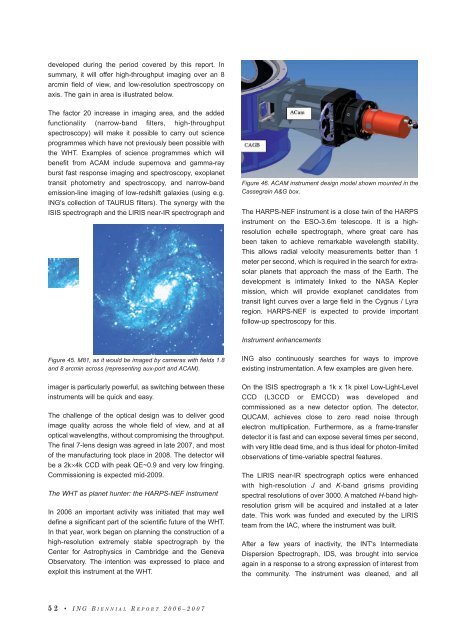PDF (6M) - Isaac Newton Group of Telescopes - Instituto de ...
PDF (6M) - Isaac Newton Group of Telescopes - Instituto de ...
PDF (6M) - Isaac Newton Group of Telescopes - Instituto de ...
Create successful ePaper yourself
Turn your PDF publications into a flip-book with our unique Google optimized e-Paper software.
<strong>de</strong>veloped during the period covered by this report. In<br />
summary, it will <strong>of</strong>fer high-throughput imaging over an 8<br />
arcmin field <strong>of</strong> view, and low-resolution spectroscopy on<br />
axis. The gain in area is illustrated below.<br />
The factor 20 increase in imaging area, and the ad<strong>de</strong>d<br />
functionality (narrow-band filters, high-throughput<br />
spectroscopy) will make it possible to carry out science<br />
programmes which have not previously been possible with<br />
the WHT. Examples <strong>of</strong> science programmes which will<br />
benefit from ACAM inclu<strong>de</strong> supernova and gamma-ray<br />
burst fast response imaging and spectroscopy, exoplanet<br />
transit photometry and spectroscopy, and narrow-band<br />
emission-line imaging <strong>of</strong> low-redshift galaxies (using e.g.<br />
ING's collection <strong>of</strong> TAURUS filters). The synergy with the<br />
ISIS spectrograph and the LIRIS near-IR spectrograph and<br />
Figure 46. ACAM instrument <strong>de</strong>sign mo<strong>de</strong>l shown mounted in the<br />
Cassegrain A&G box.<br />
The HARPS-NEF instrument is a close twin <strong>of</strong> the HARPS<br />
instrument on the ESO-3.6m telescope. It is a highresolution<br />
echelle spectrograph, where great care has<br />
been taken to achieve remarkable wavelength stability.<br />
This allows radial velocity measurements better than 1<br />
meter per second, which is required in the search for extrasolar<br />
planets that approach the mass <strong>of</strong> the Earth. The<br />
<strong>de</strong>velopment is intimately linked to the NASA Kepler<br />
mission, which will provi<strong>de</strong> exoplanet candidates from<br />
transit light curves over a large field in the Cygnus / Lyra<br />
region. HARPS-NEF is expected to provi<strong>de</strong> important<br />
follow-up spectroscopy for this.<br />
Instrument enhancements<br />
Figure 45. M81, as it would be imaged by cameras with fields 1.8<br />
and 8 arcmin across (representing aux-port and ACAM).<br />
imager is particularly powerful, as switching between these<br />
instruments will be quick and easy.<br />
The challenge <strong>of</strong> the optical <strong>de</strong>sign was to <strong>de</strong>liver good<br />
image quality across the whole field <strong>of</strong> view, and at all<br />
optical wavelengths, without compromising the throughput.<br />
The final 7-lens <strong>de</strong>sign was agreed in late 2007, and most<br />
<strong>of</strong> the manufacturing took place in 2008. The <strong>de</strong>tector will<br />
be a 2k×4k CCD with peak QE~0.9 and very low fringing.<br />
Commissioning is expected mid-2009.<br />
The WHT as planet hunter: the HARPS-NEF instrument<br />
In 2006 an important activity was initiated that may well<br />
<strong>de</strong>fine a significant part <strong>of</strong> the scientific future <strong>of</strong> the WHT.<br />
In that year, work began on planning the construction <strong>of</strong> a<br />
high-resolution extremely stable spectrograph by the<br />
Center for Astrophysics in Cambridge and the Geneva<br />
Observatory. The intention was expressed to place and<br />
exploit this instrument at the WHT.<br />
ING also continuously searches for ways to improve<br />
existing instrumentation. A few examples are given here.<br />
On the ISIS spectrograph a 1k x 1k pixel Low-Light-Level<br />
CCD (L3CCD or EMCCD) was <strong>de</strong>veloped and<br />
commissioned as a new <strong>de</strong>tector option. The <strong>de</strong>tector,<br />
QUCAM, achieves close to zero read noise through<br />
electron multiplication. Furthermore, as a frame-transfer<br />
<strong>de</strong>tector it is fast and can expose several times per second,<br />
with very little <strong>de</strong>ad time, and is thus i<strong>de</strong>al for photon-limited<br />
observations <strong>of</strong> time-variable spectral features.<br />
The LIRIS near-IR spectrograph optics were enhanced<br />
with high-resolution J and K-band grisms providing<br />
spectral resolutions <strong>of</strong> over 3000. A matched H-band highresolution<br />
grism will be acquired and installed at a later<br />
date. This work was fun<strong>de</strong>d and executed by the LIRIS<br />
team from the IAC, where the instrument was built.<br />
After a few years <strong>of</strong> inactivity, the INT's Intermediate<br />
Dispersion Spectrograph, IDS, was brought into service<br />
again in a response to a strong expression <strong>of</strong> interest from<br />
the community. The instrument was cleaned, and all<br />
52 • ING BIENNIAL R EPORT 2006–2007
















